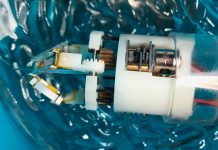 Prompt delivery of medicines to the affected area of the body is the key to effective and rapid recovery. Scientists conducted their first experiments on mice using miniature robotic devices moving through the digestive system.
Prompt delivery of medicines to the affected area of the body is the key to effective and rapid recovery. Scientists conducted their first experiments on mice using miniature robotic devices moving through the digestive system.
The main task of the tested robots is to help cure intestinal tumors. The devices offered for testing neither have complex mechanisms or electronics, nor require additional energy sources. The design of a microrobot is quite simple. This is a two-layer ball, up to 20 micrometers, the inner surface of which is made of magnesium, and the outer surface – of parylene, a material resistant to gastric juice. Medicine is located between the layers.
In the outer shell of parylene, there is a paraffin-filled hole (2 microns in diameter). In the course of the experiment, mice that got hungry after the 8-hour “dieting” were given a portion of microrobots. The trajectory of the device’s movement inside the bowel was monitored with optoacoustic tomography. When the balls reached the control point, they were irradiated with an infrared laser penetrating the living tissue and absorbed by the magnesium ball. The microrobot was heated and the paraffin “plug” melted. The liquid entering through the hole in the ball reacted with the magnesium, and gas bubbles were released from the hole.
The robot turned into an object, accelerated by a jet, stuck to the intestinal walls. The shell of parylene was broken, and the medication was delivered to the control point. The remains of the microrobot left the body naturally.
So far, it’s impossible to reach precision – only a part of the robots delivered medicines to the given point. The rest landed nearby. However, such delivery is much more effective than simple ingestion of pills, spreading the drug throughout the body, which sometimes has negative side effects.






